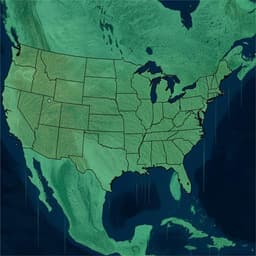
Earth Sciences
Hidden vulnerability of US Atlantic coast to sea-level rise due to vertical land motion
L. O. Ohenhen, M. Shirzaei, et al.
This groundbreaking study by Leonard O. Ohenhen, Manoochehr Shirzaei, Chandrakanta Ojha, and Matthew L. Kirwan reveals alarming findings about the vulnerability of the US Atlantic coast to sea-level rise. By thoroughly analyzing satellite data, the researchers uncover that significant subsidence rates are putting coastal marshes at risk, with many losing elevation faster than anticipated. Discover how this work reshapes our understanding of marsh vulnerability!
~3 min • Beginner • English
Introduction
Coastal zones provide essential ecological and socioeconomic services, yet they are highly vulnerable to hazards intensified by climate change, notably sea-level rise (SLR). The US Atlantic coast, a populous and economically significant region with extensive wetlands, is a hotspot of relative SLR driven by ocean dynamics, morphology, and especially vertical land motion (VLM) from processes such as sediment compaction, groundwater extraction, and glacial isostatic adjustment. Increased coastal flooding, erosion, and wetland loss have been observed and are expected to worsen. Despite this, vulnerability assessments often lack high-resolution, spatially extensive measurements of VLM, particularly across wetlands, leading to underestimated risks. This study aims to generate a high-precision, spatially semi-continuous VLM map for the US Atlantic coast and to quantify how subsidence influences exposure and vulnerability of different land covers—especially coastal marshes—to contemporary SLR.
Literature Review
Prior studies highlight accelerating global and regional SLR and the compounding role of local subsidence in elevating relative sea levels and flood risk. Conventional approaches often rely on sparse, point-wise measurements (e.g., tide gauges, field-based accretion and elevation measurements) that may not capture shallow and deep subsidence components, thereby underestimating VLM and wetland vulnerability. The IPCC AR6 commonly uses background rates from tide-gauge trends that can miss shallow subsidence effects. Field monitoring of wetlands (e.g., SET-MH stations, accretion cores) provides accurate local data but lacks the spatial coverage needed for large-scale assessments. Interferometric SAR (InSAR) has emerged as a powerful technique for mapping deformation with high spatial and temporal resolution and has been successfully applied to coasts and wetlands globally, but comprehensive, high-resolution VLM datasets for the US Atlantic coast have been lacking. This study leverages InSAR and GNSS to overcome these limitations and refine estimates of coastal vulnerability.
Methodology
The authors combined multi-sensor SAR datasets—Sentinel-1A/B (C-band; 2015–2020; 15 frames, 3057 images; 7005 interferograms with temporal/perpendicular baselines up to 500 days/700 m) and ALOS (L-band; 2007–2011; 81 frames; 13,055 interferograms with temporal/perpendicular baselines up to 1500 days/2500 m)—with 173 GNSS stations (2007–2020) covering up to ~100 km inland along the US Atlantic coast. Processing used the multitemporal wavelet-based InSAR (WabInSAR) algorithm to generate LOS velocity time series: noisy pixels were filtered, topography-correlated atmospheric delays and ionospheric artifacts mitigated, and 2D sparse phase unwrapping applied. Elite pixels (average coherence > 0.7 and normally distributed phase noise) were retained, corrected for orbital and atmospheric errors, and LOS velocities estimated via robust, reweighted least squares. Sentinel-1 and ALOS LOS maps were mosaicked and transformed to a global reference frame via affine transformation. A unified weighted least-squares joint optimization then combined two LOS measurements (Sentinel-1 and ALOS) with interpolated GNSS east, north, and up velocities to solve for 3D deformation (E, N, U) at each elite pixel (~38 million pixels). Weights reflected sensor-specific uncertainties (1 mm/yr Sentinel-1 LOS, 3 mm/yr ALOS LOS) and distance-weighted GNSS uncertainties. Precision was quantified via error propagation to derive per-pixel variance-covariance and standard deviations; accuracy was validated by comparison with 41 independent GNSS stations, yielding SDs of 0.22, 0.18, and 1.28 mm/yr for E, N, and U differences, respectively, with near-zero means. VLM (vertical) rates were integrated with the 2019 USGS National Land Cover (NLC) database (30 m) by resampling and simplifying to eight classes. Exposure to subsidence for each land cover was defined as the fraction of pixels exhibiting subsidence and summarized by mean VLM and SD. For sea-level projections comparison, VLM near 12 NOAA tide gauges was averaged within 200 m of gauges and linearly projected (2020–2100) to compare with IPCC AR6 VLM components; uncertainties used InSAR pixel SDs. Wetland vulnerability was assessed with a vertical resilience (VR) index defined as VR = VLM − SLR, with lower and upper bounds VRlower = VLM − 2SD − SLR and VRupper = VLM + 2SD − SLR, approximating a 90% confidence interval. Wetlands were split into low- and high-elevation classes using ZMHW (normalized to mean high water) with threshold ZMHW ≥ 1.0 for high elevation. SLR was corrected for local VLM using median GNSS up velocities near tide gauges. The final wetland dataset contained ~1.4 million pixels (~1300 km²).
Key Findings
- A spatially semi-continuous VLM map at ~50 m resolution and mm-level precision shows that approximately 90% of ~38 million pixels along the US Atlantic coast are subsiding. Many urban areas exhibit subsidence rates exceeding 3 mm/yr; hotspots include Charleston (SC), Brunswick (GA), and the Chesapeake Bay region with localized rates >5 mm/yr. Some localized uplift is observed, consistent with groundwater recharge in parts of Delaware Bay and the Peninsula.
- Comparison with IPCC AR6 VLM components at 12 tide gauges (projected 2020–2100) shows that IPCC VLM contributions to relative sea level are underestimated at 7 gauges (e.g., Atlantic City, Cape May, Beaufort, Wilmington, Charleston I, Trident Pier) and overestimated at 1 (Sewells Point), with 4 within ±20% difference. At Cape May, Charleston I, and Trident Pier, discrepancies exceed 1 mm/yr, implying significant local projection uncertainties.
- Land cover exposure: Along the entire US Atlantic coast, dominant land covers are wetlands (44.5%), forests (26.3%), cultivated crops (16.8%), and developed (8.1%). Mean VLM (subsidence) rates across major classes range from about −1.3 to −1.7 mm/yr. Agricultural lands (cultivated crops) show among the highest mean subsidence (−1.7 ± 1.3 mm/yr) and the greatest observed maximum sinking, exceeding 11.8 mm/yr.
- Regional examples: In the Chesapeake Bay area, mean subsidence rates are −2.6 ± 1.4 mm/yr (wetlands), −2.5 ± 1.4 mm/yr (cultivated crops), and −2.1 ± 0.8 mm/yr (forests). In the GA–SC–NC coast, wetlands and forests dominate exposure (61.6% and 27.1% of land cover, respectively), with mean subsidence −1.7 ± 1.0 mm/yr (wetlands) and −1.6 ± 0.9 mm/yr (forests).
- Wetland vulnerability: Using VR = VLM − SLR (with 90% confidence bounds), 57.6–100% of marshes are currently losing elevation relative to SLR across the US Atlantic coast, largely independent of marsh elevation class (low vs high). This contrasts with earlier point-based accretion datasets indicating deficits in 43–53% of marshes; the discrepancy is primarily due to inclusion of subsidence in VLM. Results imply previous assessments substantially underestimated marsh vulnerability by omitting shallow and deep subsidence.
Discussion
Findings demonstrate widespread subsidence along the US Atlantic coast that significantly augments relative SLR, flood frequency, and hazard exposure for infrastructure, ecosystems, and populations in major coastal cities. Agricultural lands exhibit high subsidence, potentially driven by groundwater overdraft and soil organic oxidation, heightening risk of salinization, surge flooding, and loss of arable land. Forest subsidence contributes to the spread of ghost forests and ecological shifts along the coastal plain, with implications for carbon storage and ecosystem services. The InSAR-derived VLM rates refine local relative SLR estimates and reveal that current projections (e.g., IPCC AR6) can mischaracterize site-specific contributions of land motion, undermining inundation modeling and adaptation planning. For wetlands, integrating subsidence shows a negative VLM–SLR balance in most marshes (58–100%), indicating acute vulnerability and the potential for accelerated loss without accounting for future changes. The study underscores the necessity of incorporating high-resolution VLM into coastal risk assessments, wetland survival metrics, and adaptation strategies regionally and in other global subsiding deltaic and coastal systems.
Conclusion
This study delivers a high-resolution, spatially semi-continuous map of vertical land motion for the US Atlantic coast by integrating Sentinel-1 and ALOS InSAR with GNSS, enabling improved characterization of subsidence across land cover types. Results reveal pervasive subsidence (>3 mm/yr in many locations), substantial departures from IPCC VLM components at several tide gauges, and extensive marsh vulnerability, with 58–100% of marshes losing elevation relative to SLR when subsidence is included. The work highlights that prior assessments underestimated vulnerability by neglecting shallow and deep subsidence and demonstrates the value of InSAR-based VLM for refining local relative SLR and inundation models. Future research should incorporate accelerations in SLR and vertical accretion, disentangle subsidence drivers (e.g., groundwater extraction, compaction), enhance wetland monitoring networks to align with remote sensing footprints, and integrate VLM-informed projections into coastal adaptation and ecosystem management.
Limitations
- Vulnerability estimates assume current rates of subsidence and SLR; potential future accelerations in either SLR or marsh accretion are not modeled, so estimates represent current to worst-case conditions within the stated confidence bounds.
- Validation over wetlands is limited by sparse spatial overlap between InSAR pixels and SET-MH monitoring stations, reflecting differing site selection and observation constraints.
- Spatial precision varies; higher standard deviations occur in regions like Chesapeake Bay due to fewer GNSS stations and temporal differences between ALOS and Sentinel-1 acquisition periods.
- IPCC comparison uses linear projections (2020–2100) and local averaging within 200 m of tide gauges; localized heterogeneity and temporal variability may introduce additional uncertainty.
- InSAR coherence and elite-pixel selection favor less inundated surfaces; persistently flooded areas may be underrepresented.
Related Publications
Explore these studies to deepen your understanding of the subject.







